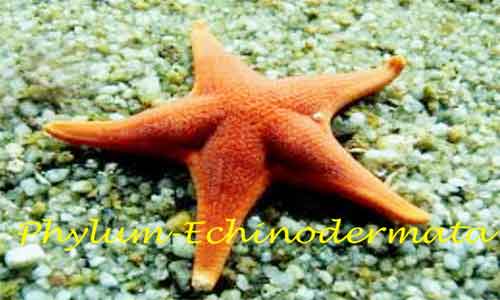The term ‘Echinodermata’ is derived from Greek words ‘echinos’ meaning ‘spiny’ and ‘dermos’ meaning ‘skin’. The representatives of phylum Echinodermata are absolutely marine organisms and this phylum contains about 7,000 known living species. Among them, notable species are sea urchins, brittle stars, sand dollars, sea cucumbers, sea stars, etc. Scientists did not trace any freshwater or terrestrial echinoderms till now. Echinoderms are unique shaped colorful organisms. They have well-developed organ systems which are ecologically and geologically very important. The water vascular system is the very important key feature of echinoderms through which circulation of nutrients, gaseous exchange, and waste elimination takes place. They have a pentamerous radial symmetrical body with calcareous endoskeleton and their body size ranges from less than an inch to over three feet in diameter. Under the skin of echinoderm`s body, many small plates overlap and forms calcareous endoskeleton. Their body also bears podia which are small extensions of flesh by which water vascular system is operated. In this case, water pressure, body muscles and nervous system also play an important role to control water vascular system.
General Characteristics of Phylum Echinodermata
- They are commonly known as spiny skinned organisms.
- They are exclusively marine organisms which usually inhabit in the bottom of the sea and move slowly. But a few species are free-swimming and some are affixed to the substratum.
- They have a uniquely spherical, elongated or star-shaped body with organ level of organization.
- Echinoderms are triploblastic organisms with a true coelom.
- The body does not have a segment and lacks the head.
- They have calcareous endoskeleton and the surface of the body is covered with calcareous spicules.
- The mouth is located on the ventral side (oral side) while the anus is located on the dorsal side (aboral side).
- The body contains water vascular system (ambulacral system) through which circulation of nutrients, gaseous exchange, and waste elimination takes place.
- In the water vascular system, madreporite is present as an inlet canal while tube feet are situated on the radial canal which assists in respiration, locomotion, and food capture.
- They have an open type blood circulatory system with five radiating vessels. In this case, the heart is absent and blood does not contain any respiratory pigment. This system is also known as haemal and perihaemal system.
- Different types of respiratory organs are found in different echinoderms such as dermal branchiae or papulae in starfish, genital bursae in the brittle star, peristominal gills in sea urchin and cloacal respiratory trees in Holothurians.
- They have complete digestive tract but in some species such as a brittle star, it is incomplete.
- Poorly developed sense organs are found (tactile organs, terminal tentacles, chemoreceptors, etc).
- They have no brain and nerve ring and radial nerve cords collectively make the nervous system.
- Sexes are separate and sexual reproduction takes place. In most of the species, external fertilization occurs but in few forms, fertilization is internal.
- The larval forms are ciliated and bilaterally symmetrical and in echinoderms, various larval forms are found such as Bipinnaria, Brachiolaria (starfish), Pluteus (sea urchin), Auricularia (sea cucumber), Ophioputeus (brittle star), and Doliolaria (feather star).
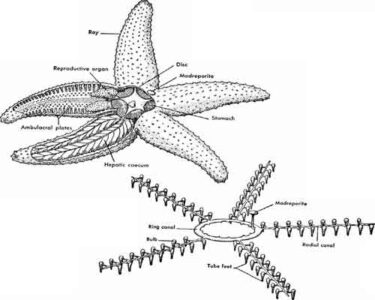
Image showing water vascular system in echinoderms
You Might Also Read: Phylum Mollusca and Its Classification
Classification of Phylum Echinodermata
Phylum Echinodermata is divided into the following five classes:
- Asteroidea
- Ophiuroidea
- Echinoidea
- Holothuroidea
- Crinoidea
Class-1: Asteroidea
- They are commonly known as starfish or sea stars.
- This class contains about 15,00 species which are found within 6000 m depth ranges.
- They have a radial symmetrical, flattened, star-like body with five arms.
- The mouth is pentagonal which is located centrally on the ventral side (oral surface) while the anus is on the dorsal side (aboral surface).
- They have flexible and calcareous endoskeleton and the surface of the body may be smooth, spiny or granular and covered with calcareous overlapping plates.
- They are carnivorous and mostly feed on benthic invertebrates.
- They have a calcareous opening or madreporite on the dorsal side to filter the water into the water vascular system.
- LThe radial canal contains tube feet with suckers which aid in locomotion and capturing food.
- They bear wrench or claw-shaped structure which is known as pedicellaria for cleaning and capturing tiny prey.
- LRespiration takes place through papulae.
- Indirect development occurs with different larval forms (Bipinnaria or Brachiolaria).
Examples: Asterias rubens (Common Starfish), Astropecten articulates (Royal starfish)
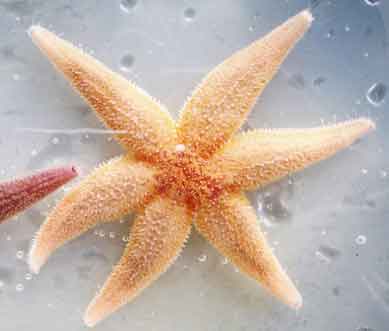
Asterias rubens (Common Starfish)
Class-2: Ophiuroidea
- They are commonly known as Brittle stars or ophiuroids or serpent stars.
- They have pentamerous disc-shaped flat body with five slender, long, and whip-like arms that reach up to 60 cm in length.
- The water vascular system contains one madreporite.
- The tube feet do not contain suckers and ampullae.
- Respiration and excretion take place through cilia-lined sacs or bursae.
- The body does not have an anus, ambulacral groove, and intestine. In this case, egestion and ingestion occur through the mouth.
- They are scavengers or detrivores but sometimes they take small crustaceans or worms.
- Their lifespan ranges up to five years.
- In most species, sexes are separate but few are hermaphroditic or protandric.
- Indirect development occurs with the distinct larval stage (Pluteus larva).
Example: Ophiothrix fragilis (Brittle stars), Ophioderma longicauda(smooth brittle star)
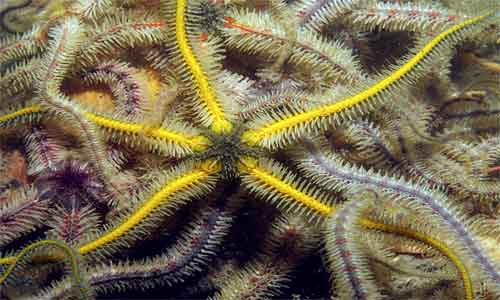
Ophiothrix fragilis (Brittle stars)
Class-3: Echinoidea
- They are also known as sea urchins and sand dollars which inhabit all oceans within 5000 meters depth ranges.
- This class contains about 950 species. Among them, the most notable species are sea urchins, sand dollars, heart urchins, etc.
- They have a round (sea urchin), oval or heart-shaped (heart urchin), or flattened (sand dollar) body.
- The mouth is located on the ventral side while the anus is on the dorsal surface of the body.
- The body of the echinoids has a rigid skeleton or test which is made up of calcium carbonate or ‘stereom’ which makes the interlocking plates of the skeleton.
- The body is covered with spines and the body color may be purple, brown or tan.
- They have water-filled tube feet with suckers which aid in locomotion.
- The echinoids are very popular among the shell collectors. In some areas, sea urchins, eggs are eaten by many people.
- They have chewing apparatus which is known as Aristotle’s Lantern.
- Indirect development occurs with the distinct larval stage (Echinopliteus larva).
Examples: Echinus esculentus (Common sea urchin), Echinarachnius parma (the Common Sand Dollar)
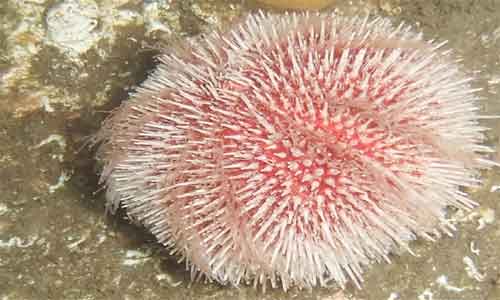
Echinus esculentus (Common sea urchin)
Class-4: Holothuroidea
- Holothurians are also known as sea cucumbers which are found in all oceans with about 1700 described species.
- They inhabit in shallow water areas to deep ocean floors.
- They have leathery skin and an elongated body with black, brown, or olive green in colors.
- The length of the body ranges from three cm to one meter with a diameter of 24 cm.
- The mouth and anus are situated on the opposite side of the body.
- They have five rows of sucking type tube feet which run from the mouth to the anus along the cylindrical body.
- The body does not contain arms, spines, and pedicellariae.
- 10-30 tentacles are present around the mouth.
- They have ring canal around the gut with 1-50 pollian vesicles for hydraulic function.
- Five radial canal arises from the ring canal with rows of ampullae.
- A short stone canal is present which arises from the ring canal that follows the madreporite.
- Respiration occurs through the cloacal respiratory trees which branch out near the rectum for gas exchange.
- Holothurians are dioecious and their fertilization is external.
- Development is indirect with different types of planktotrophic or lecithotrophic larval stages (Auricularia, doliolaria, pentactula larva).
Examples:Cucumaria miniata (Orange sea cucumber), Holothuria leucospilota (the black sea cucumber)
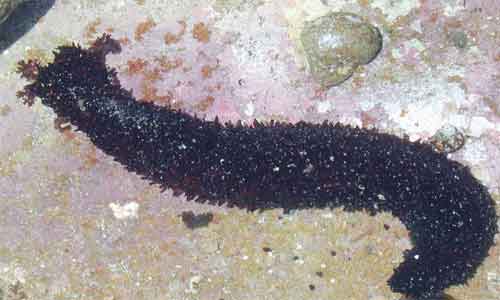
Holothuria leucospilota (the black sea cucumber)
Class-5: Crinoidea
- They are commonly known as sea lilies and feather stars.
- This class contains about 700 living species which inhabit deep waters.
- They have a cup-shaped body with five or more flexible and active arms.
- At the edge of the arms, feathery projections are present which are known as pinnules that bear the reproductive organs with numerous tube feet without suckers.
- On the dorsal (oral) surface mouth and anus are present.
- They are passive suspension feeders which feed on plankton and small particles of debris.
- They do not contain madreporite but spines and pedicellariae are present.
- They bear water vascular system which controls hydraulic pressure in the tube feet.
- They are dioecious and development is indirect with the distinct larval stage (Vitellaria larva).
Examples: Antedon mediterranea (Mediterranean feather star), Rhizocrinus lofotensis
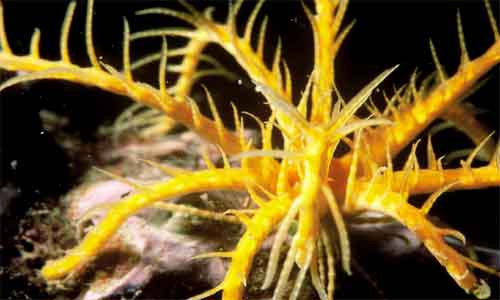
Antedon mediterranea(Mediterranean feather star)
Concluding Remarks
Echinodermata makes the largest animal phylum with about 7000 living species. They provide many benefits to human beings. Sea urchins and sea cucumbers are very delicious food for many people and some have medicinal value. Besides these, aesthetically, they have brilliant varieties of color forms which provide a source of amazement and enjoyment to human beings.

